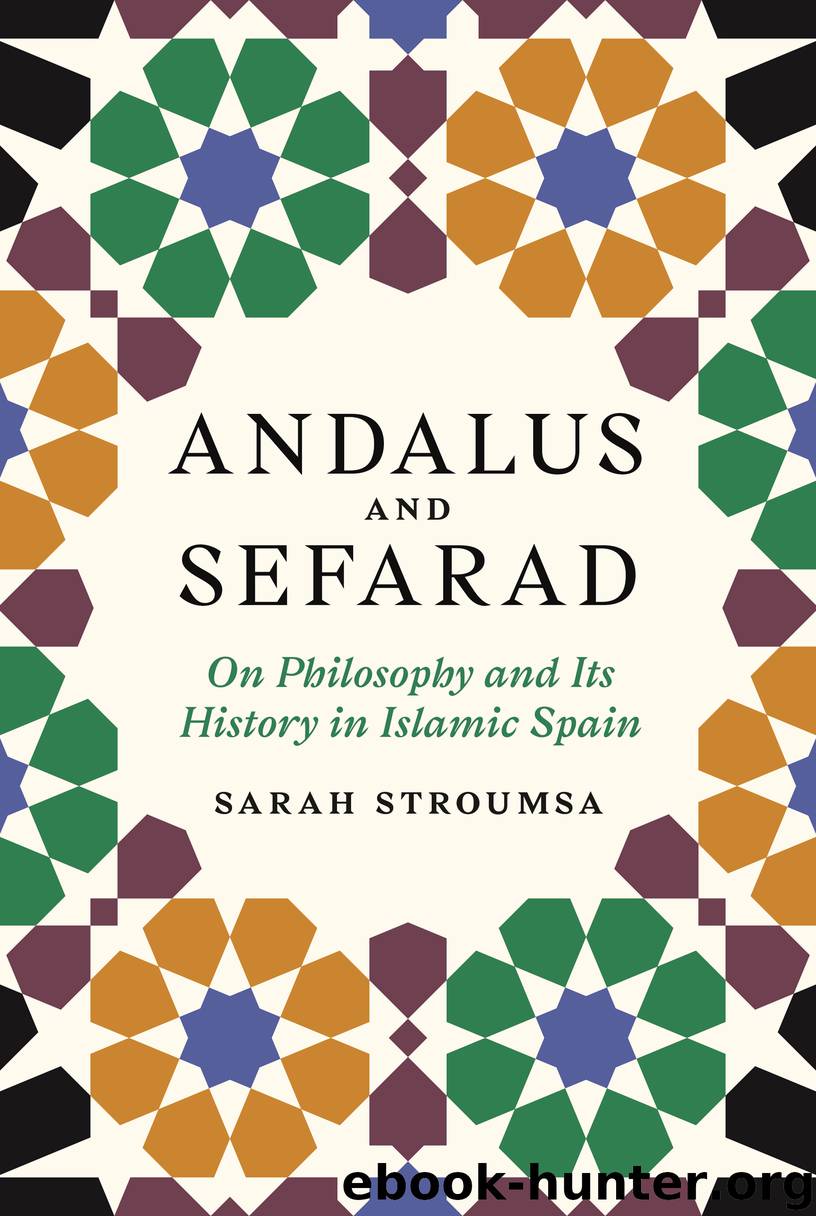Andalus and Sefarad by Stroumsa Sarah;

Author:Stroumsa, Sarah;
Language: eng
Format: epub
Publisher: Princeton University Press
Published: 2019-06-11T00:00:00+00:00
Pseudo-Empedoclean Neoplatonism
The origins of the theory of an Andalusian “school of Pseudo-Empedocles” go back to the nineteenth century, when Salomon Munk and David Kaufmann believed they had found in three late (fourteenth- and fifteenth-century) Hebrew Kabbalistic texts fragments of the Book of Five Substances. This book was first attributed to Empedocles by Shem Tov Ibn Falaqera in his introduction to the Hebrew epitome of Ibn Gabirol’s Source of Life. Falaqera also suggested that in his book, Ibn Gabirol followed “opinions of the ancient philosophers that are similar to those mentioned by Empedocles in the book he composed on the five substances.”56 The theory, which originated with the discovery of these late Jewish texts, received its fuller development by Asín Palacios, who, relying on the information of al-Shahrastānī and al-Shahrazūrī, thought that he detected the Pseudo-Empedoclean tradition in a variety of Arabic Jewish and Muslim texts, continuing all the way to Hebrew Kabbalah and Latin scholasticism.57 The Pseudo-Empedoclean system, as analyzed by Munk, Kaufmann, and Asín Palacios, involved a complex reconstruction from fragments of many different texts. It presented a Neoplatonist doctrine in which the emanation of the pure, spiritual prime element (al-ʿunṣur al-awwal) by the Creator’s will is followed by the emanation of the intellect, the universal soul (al-nafs al-kulliyya), nature (al-ṭabīʿa), and secondary matter. Voluntarist creationism and the existence of a prime element prior to the universal intellect were perceived as distinctive hallmarks that set this doctrine, supposedly typical of the Iberian peninsula, apart from classical Neoplatonism.58 Characteristic (but not exclusive) imagery and vocabulary, such as the imagery of the ladder, the distinction between the kernel or core and the outer shells, and the image of the source (yanbūʿ), were also identified in the cosmogony and soteriology of this doctrine.59
With few exceptions, most specifically a critical article by Samuel Miklós Stern, the existence of Pseudo-Empedocles has been taken for granted for almost a century.60 This near-consensus was reversed in 1997 when Daniel De Smet published his Empedocles Arabus, arguing persuasively that Pseudo-Empedocles did not constitute a distinct philosophical system. There is, hence, no single coherent “Pseudo-Empedoclean system” identifiable in the various texts that have been associated with Pseudo-Empedocles. De Smet distinguishes between the so-called Pseudo-Empedoclean doctrine and what he calls the Arab Empedocles. Both represent for him but two of the many faces of Arabic Neoplatonism. Treating either of them as a separate school is neither correct nor helpful. As a main source for what has evolved into the so-called Pseudo-Empedocles, De Smet, following Ulrich Rudolph, pointed to the Pseudo-Ammonius.61 It is possible that Falaqera had in mind this doxology when he alluded to the ancient philosophers whose system Ibn Gabirol may have been following.
De Smet was not alone in his skepticism. Josef van Ess, for example, has described the Pseudo-Empedocles doctrine as yet another phantom of the scholarship regarding al-Andalus.62 Nevertheless, it seems to me imperative to ensure that, as we chase away the phantom, we do not at the same time disperse the insights that it brought to the fore.
Download
This site does not store any files on its server. We only index and link to content provided by other sites. Please contact the content providers to delete copyright contents if any and email us, we'll remove relevant links or contents immediately.
| Hadith | History |
| Law | Mecca |
| Muhammed | Quran |
| Rituals & Practice | Shi'ism |
| Sufism | Sunnism |
| Theology | Women in Islam |
The History of Jihad: From Muhammad to ISIS by Spencer Robert(2516)
Nine Parts of Desire by Geraldine Brooks(2290)
The Turkish Psychedelic Explosion by Daniel Spicer(2257)
The First Muslim The Story of Muhammad by Lesley Hazleton(2165)
The Essential Rumi by Coleman Barks(1944)
1453 by Roger Crowley(1892)
The Last Mughal by William Dalrymple(1799)
Trickster Travels: A Sixteenth-Century Muslim Between Worlds by Davis Natalie Zemon(1788)
Muhammad: His Life Based on the Earliest Sources by Martin Lings(1576)
God by Aslan Reza(1570)
by Christianity & Islam(1566)
A Concise History of Sunnis and Shi'is by John McHugo(1521)
Magic and Divination in Early Islam by Emilie Savage-Smith;(1471)
No God But God by Reza Aslan(1443)
The Flight of the Intellectuals by Berman Paul(1405)
Art of Betrayal by Gordon Corera(1370)
Nothing to Envy by Barbara Demick(1338)
What the Qur'an Meant by Garry Wills(1334)
Getting Jesus Right: How Muslims Get Jesus and Islam Wrong by James A Beverley & Craig A Evans(1281)
